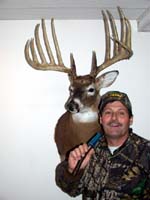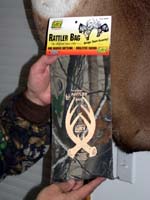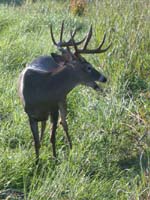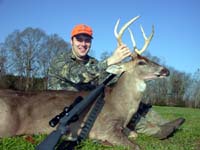
|
Features
|
|
|
|
Books
|
|
|
|
Fun & Games
|
|
|
|
Contact Us
|
|
|
John's Journal... Entry 173, Day 3
SECRETS FOR CALLING BUCKS
Prerut Calling
 EDITOR'S
NOTE: Jerry Peterson is the founder and product
designer of Woods Wise Products, the makers of quality game calls in Franklin,
Tennessee.
EDITOR'S
NOTE: Jerry Peterson is the founder and product
designer of Woods Wise Products, the makers of quality game calls in Franklin,
Tennessee.
QUESTION: Let's talk about the grunt call during the
prerut.
PETERSON: In the prerut, the bucks are much more interested in doe communication.
In the prerut phase, you'll have the most success with the long bleats,
such as those done with the cans or a call like the Blue Doe. These are
breeding sounds. Another favorite of mine is a call we produce called
the Breeding Bellow, which is a punctuated in-heat sound.
 At
this particular time, the bucks have broken away from the bachelor group
because it makes more sense for the bucks to travel by themselves and
find their own does than for a whole group of bucks to find one poor little
doe. They key in on the sound the does are making to help them find those
does. That is why, as a hunter, it becomes highly productive to use the
doe sounds when going into the prerut and on into the rut phase.
At
this particular time, the bucks have broken away from the bachelor group
because it makes more sense for the bucks to travel by themselves and
find their own does than for a whole group of bucks to find one poor little
doe. They key in on the sound the does are making to help them find those
does. That is why, as a hunter, it becomes highly productive to use the
doe sounds when going into the prerut and on into the rut phase.
I still use the ABC sounds I mentioned earlier along with the estrus bleat and the Breeding Bellow. At this time, the buck's attention begins to build with other bucks, and you can start some serious fighting and rattling sounds. In the prerut phase, you have a small percentage of available does and virtually the entire buck population looking for those does, so competition is at its highest. This is usually when rattling pays off. This is also when you will see scrapes worked to their maximum.
 QUESTION:
Can you become a little more aggressive with your rattling in the prerut?
QUESTION:
Can you become a little more aggressive with your rattling in the prerut?
PETERSON: You must remember that when you use an aggressive sound (like
rattling, aggravated grunts, snorts, sniff wheezes), the deer will respond
in one of two ways. He'll either come running to you, or he'll leave the
area. So my advice is to always begin a calling sequence with something
non-aggressive. I'd start with one of the ABC calls, following with a
breeding sound, then the rattling and grunting series. If you have a buck,
which has just had his tail whipped by another buck, I don't care how
big he is, he will probably go the other way.
 Remember
fighting is the last resort for deer. They'd rather use intimidation or
body posture because injury at this particular time would be very detrimental
in terms of participating in the rut. Fights are usually brief and infrequent.
When you do see a knock-down, drag-out fight during this period, it is
between two bucks that are highly confident and figure they are the top
dogs. They have sized-up their competitors and in their own minds, they
think they can beat them. Those conditions are very rare. Most hunters
will see a lot of sparring, but never an all-out fight.
Remember
fighting is the last resort for deer. They'd rather use intimidation or
body posture because injury at this particular time would be very detrimental
in terms of participating in the rut. Fights are usually brief and infrequent.
When you do see a knock-down, drag-out fight during this period, it is
between two bucks that are highly confident and figure they are the top
dogs. They have sized-up their competitors and in their own minds, they
think they can beat them. Those conditions are very rare. Most hunters
will see a lot of sparring, but never an all-out fight.
For more information on Woods Wise Products, call 1-800-735-8182, or visit their website at www.woodswise.com.
TOMORROW: THE RUT AND POST-RUT
Check back each day this week for more about SECRETS FOR CALLING BUCKS ...
Day 1 - Understanding The
Rut Phases
Day 2 - Secrets For Calling Bucks
Day 3 - Prerut Calling
Day 4 - The Rut and Post-Rut
Day 5 - The Importance Of Calling